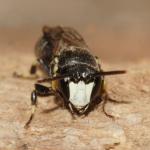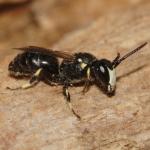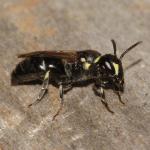Previously Hylaeus gibbus (Saunders,1850). This species was considered by Warncke (1970) as being a subspecies of H. confusus but, morphologically, the males of each species are abundantly distinct from each other and most other authors recognise them as separate species. Sometimes both species fly together.
Confined to southern England. Generally a rare bee, though occasionally numerous in favoured heathland sites. Widely distributed throughout much of Europe, Anatolia and the Caucasus, and northern Morocco (Koster 1986).
Given as Rare (RDB 3) in Shirt (1987) and by Falk (1991).
In Britain, most records are from heathlands, especially in areas close to scrub or scattered trees, but it has additionally been found in open deciduous woodland (pers. obs.).
Univoltine; June to August.
Females have been observed entering burrows in dead wood lying on the ground (pers. obs.). In the Natural History Museum, London, there are specimens of H. incongruus reared from a dead common reed stem collected in Austria. In France, it is reported to nest in dead bramble stems (Benoist 1959).
Bramble (Rubus fruticosus agg.), dandelion (Taraxacum sp.) species, hogweed (Heracleum sphondylium), tormentil (Potentilla erecta), wild angelica (Angelica sylvestris) and wild parsnip (Pastinaca sativa).
None known.




